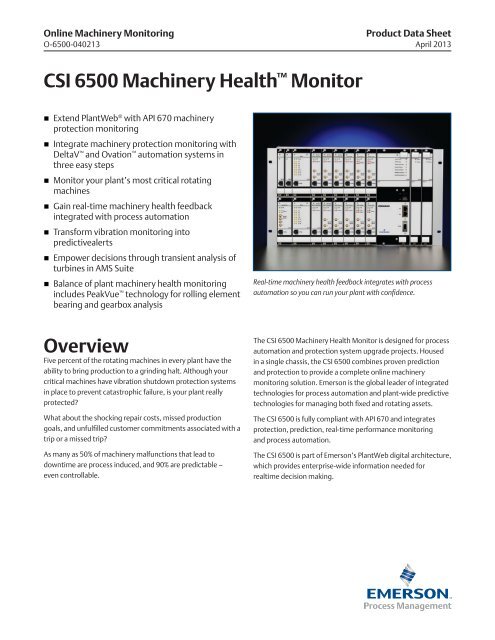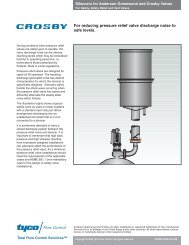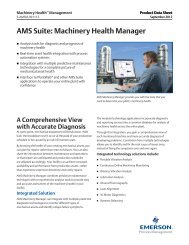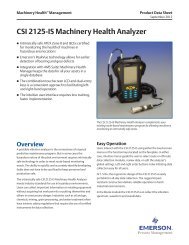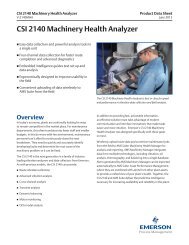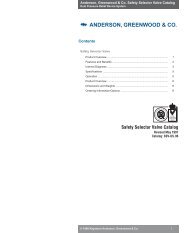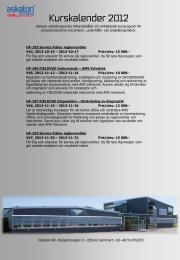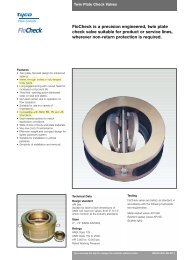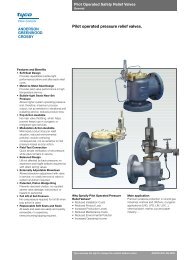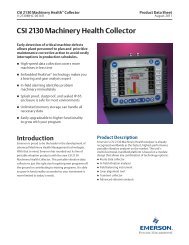CSI 6500 Data Sheet - Emerson Process Management
CSI 6500 Data Sheet - Emerson Process Management
CSI 6500 Data Sheet - Emerson Process Management
Create successful ePaper yourself
Turn your PDF publications into a flip-book with our unique Google optimized e-Paper software.
Online Machinery Monitoring<br />
O-<strong>6500</strong>-040213<br />
Product <strong>Data</strong> <strong>Sheet</strong><br />
April 2013<br />
<strong>CSI</strong> <strong>6500</strong> Machinery Health Monitor<br />
• Extend PlantWeb ® with API 670 machinery<br />
protection monitoring<br />
• Integrate machinery protection monitoring with<br />
DeltaV and Ovation automation systems in<br />
three easy steps<br />
• Monitor your plant’s most critical rotating<br />
machines<br />
• Gain real-time machinery health feedback<br />
integrated with process automation<br />
• Transform vibration monitoring into<br />
predictivealerts<br />
• Empower decisions through transient analysis of<br />
turbines in AMS Suite<br />
• Balance of plant machinery health monitoring<br />
includes PeakVue technology for rolling element<br />
bearing and gearbox analysis<br />
Real-time machinery health feedback integrates with process<br />
automation so you can run your plant with confidence.<br />
Overview<br />
Five percent of the rotating machines in every plant have the<br />
ability to bring production to a grinding halt. Although your<br />
critical machines have vibration shutdown protection systems<br />
in place to prevent catastrophic failure, is your plant really<br />
protected<br />
What about the shocking repair costs, missed production<br />
goals, and unfulfilled customer commitments associated with a<br />
trip or a missed trip<br />
As many as 50% of machinery malfunctions that lead to<br />
downtime are process induced, and 90% are predictable –<br />
even controllable.<br />
The <strong>CSI</strong> <strong>6500</strong> Machinery Health Monitor is designed for process<br />
automation and protection system upgrade projects. Housed<br />
in a single chassis, the <strong>CSI</strong> <strong>6500</strong> combines proven prediction<br />
and protection to provide a complete online machinery<br />
monitoring solution. <strong>Emerson</strong> is the global leader of integrated<br />
technologies for process automation and plant-wide predictive<br />
technologies for managing both fixed and rotating assets.<br />
The <strong>CSI</strong> <strong>6500</strong> is fully compliant with API 670 and integrates<br />
protection, prediction, real-time performance monitoring<br />
and process automation.<br />
The <strong>CSI</strong> <strong>6500</strong> is part of <strong>Emerson</strong>’s PlantWeb digital architecture,<br />
which provides enterprise-wide information needed for<br />
realtime decision making.
Online Machinery Monitoring April 2013<br />
• y API 670 Compliant<br />
• y Integrated protection and<br />
prediction monitoring<br />
• y Dual, redundant 24VDC, 120–<br />
240VAC, 50–60Hz power input<br />
• y PlantWeb Enabled: Ovation, DeltaV<br />
and AMS Suite Compatible<br />
• y Full TSI (turbine supervisory<br />
instrumentation)<br />
--<br />
Case Expansion<br />
--<br />
Differential Expansion<br />
--<br />
Thrust Position<br />
--<br />
Relative Vibration<br />
--<br />
Absolute Vibration<br />
• y Small 3U protection only rack<br />
available<br />
Protect your critical machinery through protection, prediction, performance monitoring, and PlantWeb.<br />
Flexible for Retrofits<br />
Your project may be a major revamp, including a control<br />
system and vibration monitoring system update, or you may<br />
be making improvements in phases.<br />
If Phase 1 is only a protection system upgrade, the <strong>CSI</strong> <strong>6500</strong> is<br />
uniquely designed to offer protection-only for obsolete system<br />
replacement.<br />
The <strong>CSI</strong> <strong>6500</strong> can even be deployed in a prediction-only<br />
configuration to overlay on an existing protection system.<br />
Want to use your existing instrumentation The <strong>CSI</strong> <strong>6500</strong><br />
works with any negative 24 VDC powered displacement<br />
sensors and drivers.<br />
In Phase 2 of your project, the prediction-only configuration or<br />
protection-only configuration can be upgraded at any time to a<br />
combined configuration by simply adding a few monitoring<br />
modules. The <strong>CSI</strong> <strong>6500</strong> offers the most flexible and powerful<br />
solution available for retrofit applications.<br />
A Protection System You Can Count<br />
On<br />
The <strong>CSI</strong> <strong>6500</strong> is field-proven, providing API 670 protection<br />
on the industry’s most critical equipment: steam turbine<br />
generators, gas turbines, boiler feed pumps, offshore<br />
compressors, pipeline turbo compressors, chemical industry<br />
compressors, turbo exhausters, blowers, and boosters.<br />
Missed trips, false trips, and running blind are not acceptable<br />
in your plant.<br />
The <strong>CSI</strong> <strong>6500</strong> helps prevent missed trips by using module<br />
self-health checking, instrumentation health monitoring and<br />
hot swappable, external, redundant power. External power<br />
removes heat and user “touches” away from the rack. The<br />
same architecture is used in all <strong>Emerson</strong> process automation<br />
and critical SIS systems.<br />
2<br />
www.assetweb.com
Online Machinery Monitoring April 2013<br />
The <strong>CSI</strong> <strong>6500</strong> is integrated with the Ovation and DeltaV process automation systems through an easy three step process to reduce<br />
integration time from weeks to minutes. In addition, control strategies and graphical elements are automatically created, making GUI<br />
development a snap.<br />
False trips are addressed through features such as 2oo3 voting<br />
logic for increased decision accuracy and limiting channel count<br />
to two channel modules. Two channel modules mean that<br />
swapping a protection module will affect no more than two<br />
channels – an API 670 requirement.<br />
Redundant communications ensures that the operator is never<br />
blind to machinery health information.<br />
Other features that demonstrate the flexibility of the <strong>CSI</strong> <strong>6500</strong><br />
include:<br />
• Thrust monitoring: dual channel, complementary, min/max<br />
or absolute shaft position, measuring range shift, measuring<br />
range invert<br />
• Differential Expansion: flexibility for any type of ramp<br />
configuration<br />
• Eccentricity: max., min., peak to peak, or distance from<br />
clearance reference<br />
Integrated Machinery Protection and Prediction from <strong>Emerson</strong><br />
saves hundreds of man-hours and gives you a complete, error<br />
free integration of machinery information with the DeltaV or<br />
Ovation digital control system.<br />
Typical machinery protection systems can require 2,400 steps<br />
for 24 vibration channels to complete the integration process.<br />
It typically takes up to five days for complete integration. With<br />
this many steps, network issues, additional testing time, and<br />
nuisance alarms are easily introduced. All too often, plants<br />
don’t have the time or staff to complete the integration,<br />
leaving plant operators without key machinery health<br />
diagnostics.<br />
The <strong>CSI</strong> <strong>6500</strong> eliminates this risk by easily providing machinery<br />
health diagnostics to operators through the simple three step<br />
Easy Integration with your control system.<br />
3<br />
www.assetweb.com
Online Machinery Monitoring April 2013<br />
Instrumentation<br />
While the <strong>CSI</strong> <strong>6500</strong> delivers field-based intelligence, accurate<br />
information starts with quality instrumentation.<br />
Eddy current displacement sensors are the preferred method<br />
for monitoring sleeve-bearing machines. These displacement<br />
sensors penetrate the machine case and directly monitor the<br />
motion and position of the shaft without contacting the shaft<br />
surface.<br />
Accelerometers and velometers are the industry accepted<br />
sensors for monitoring the health of gearboxes and rolling<br />
element bearings. Although temperature sensors are<br />
sometimes used to measure health, temperature alone is only a<br />
small part of the machinery health picture. When a shaft begins<br />
to rub the bearing as a result of misalignment, a displacement<br />
probe can directly track the misalignment behavior. By the time<br />
the rub is severe enough to trigger a temperature alarm, the<br />
damage is already done.<br />
Mounting location and instrumentation bracket design are<br />
both critical for quality data.<br />
A complete range of sensors, adapters, cables, connectors,<br />
converters, and fittings are available for new installations,<br />
retrofits, or replacement of sensors during an overhaul.<br />
• Thrust position<br />
• Relative radial shaft vibration<br />
• Absolute radial shaft vibration<br />
• Rotor vs. case differential expansion<br />
• Bearing case vibration<br />
• Case expansion, LVDT<br />
• Rotor bow (eccentricity)<br />
• Valve position, LVDT<br />
• Key, phase, and speed measurements<br />
Large Steam Turbine Ty<br />
Differential Expansion A<br />
Differential Expansion B<br />
X Vibration<br />
X Vibration<br />
X Vib<br />
X Vibration<br />
X Vibration<br />
X Vibration<br />
BRG-11<br />
EXC<br />
BRG-10<br />
GENERATOR<br />
BRG-9<br />
BRG-10<br />
BRG-8<br />
LPC<br />
BRG-7<br />
BRG-6<br />
Y Vibration<br />
Y Vibration<br />
Y Vibration<br />
Y Vibration<br />
Y Vibration<br />
Y Vib<br />
Case Expansion<br />
Monitor<br />
• y LVDTs mounted on both<br />
sides of the case measure<br />
expansion relative to the<br />
foundation on turbines<br />
greater than 250MW<br />
• y It is important to monitor<br />
expansion on both sides for<br />
bending, which could cause<br />
rotor to stator contact<br />
Rotor Speed Phase <strong>Process</strong> Input Shaft Absolute<br />
• y Speed monitoring –<br />
machine state information,<br />
trending and triggering<br />
acquisition<br />
• y Zero speed – signals the<br />
operator to engage turning<br />
gear or alerts that turning<br />
gear has failed<br />
• y Rotor acceleration –<br />
indicates load changes and<br />
coupling health<br />
• y Reverse rotation<br />
• y Vibration data is a vector<br />
with phase and magnitude<br />
• y Changes in phase are as<br />
important to know as<br />
changes in amplitude<br />
• y A change in phase is a key<br />
indicator of a possible<br />
• y Accepts 4-20 mA input and<br />
0-10 volt input<br />
• y Accepts RTDs and<br />
thermocouples directly<br />
• y Inputs temperature,<br />
pressure, flow, and other<br />
process parameters<br />
Valve Position Monitor<br />
• y Valve position can be used<br />
to track changes in load<br />
• y Shaft relative sensors<br />
and seismic sensors are<br />
used to mathematically<br />
produce a shaft absolute<br />
measurement<br />
• y Absolute vibration<br />
measurements are<br />
recommended for turbines<br />
250-650MW or greater<br />
Seismic<br />
• y Electrodynamic seismic<br />
sensor input for bearing<br />
housing vibration<br />
measurements<br />
4<br />
www.assetweb.com
Online Machinery Monitoring April 2013<br />
See instrument spec sheets for complete specifications about<br />
dynamic and static measurements.<br />
ATEX Conformity for selected Products in accordance<br />
with EN 50 014 and EN 50 020, certified by the PTB<br />
CAN/CSA-C22.2 No. 61010-1-04: Safety Requirements for Electrical Equipment for<br />
Measurement, Control, and Laboratory Use, Part 1: General Requirements<br />
UL Std. No. 61010-1 (2nd Edition): Safety Requirements for Electrical Equipment for<br />
Measurement, Control, and Laboratory Use, Part 1: General Requirements<br />
pical Instrumentation<br />
Rotor Position A<br />
Rotor Position B<br />
X Vibration<br />
It’s the Network<br />
<strong>Emerson</strong>'s experts ensure proper design and execution for the<br />
<strong>CSI</strong> <strong>6500</strong> implementation in the plant. From onsite assessment,<br />
installation and project management to commissioning and<br />
analysis of predictive diagnostics, <strong>Emerson</strong> offers a team of<br />
world-class professionals and support network to ensure<br />
success including:<br />
• Project Engineers design your system<br />
• Onsite Project Managers are your point of contact<br />
throughout the project<br />
• Remote analysis personnel experienced in diagnostics are<br />
available to offer a second opinion for increased confidence<br />
• Expert customer support is available 24/7 to answer the<br />
urgent questions that protection systems require<br />
• A network of world-wide support provides global coverage<br />
locally<br />
ration X Vibration X Vibration X Vibration<br />
Governor Valve Pos 2<br />
LVDT<br />
Eccentricity<br />
Case Expansion Right<br />
Differential Expansion B<br />
Differential Expansion A<br />
X Vibration<br />
Governor Valve Pos 4<br />
LVDT<br />
LVDT<br />
LPB<br />
T<br />
H<br />
RUST<br />
LPA HP<br />
BRG-5 BRG-4 BRG-3 BRG-2 BRG-1<br />
LVDT<br />
Y Vibration<br />
Y Vibration<br />
Vibration<br />
Case Expansion Left<br />
ration<br />
Y Vibration<br />
Phase B (SPR)<br />
Phase A (Prime)<br />
Y Vibration<br />
Governor Valve Pos 1<br />
LVDT<br />
Governor Valve Pos 3<br />
LVDT<br />
Case Piezoelectric Dual-Thrust Position Eccentricity Differential Expansion<br />
• y Used for rolling element bearings and<br />
gearboxes<br />
• y Also used for aero-derivative turbines<br />
where rolling element bearings are<br />
used<br />
• y Use PeakVue processing on rolling<br />
element bearings and gearboxes<br />
• y Thrust is an axial position near the<br />
thrust bearing and is one of the most<br />
critical measurements on a high-speed<br />
turbine<br />
• y At least two thrust sensors, for<br />
redundancy and for voting logic are<br />
recommended<br />
• y Thrust bearing deterioration, failure,<br />
or sudden changes in steam pressure<br />
can quickly move the rotor axially and<br />
cause collisions with rotor and stator<br />
• y A measure of rotor bow during<br />
startup, typically monitored from 0<br />
to 600 rpm<br />
• y Rotor bow changes when thermal<br />
conditions change during startup,<br />
shutdown or even production state<br />
• y At least one displacement sensor in<br />
the high pressure section targets an<br />
eccentricity collar<br />
• y Differential expansion is a radial<br />
rotor position measurement<br />
• y Differential expansion sensors<br />
are mounted on the case and<br />
measure the position of the<br />
rotor relative to the position of<br />
the case<br />
• y Recommended for turbines<br />
250MW and greater<br />
• y Configurations may be ramp or<br />
complementary<br />
5<br />
www.assetweb.com
Online Machinery Monitoring April 2013<br />
With <strong>Emerson</strong>’s PlantWeb digital architecture, your plant is<br />
blanketed with predictive, digital intelligence that gives you<br />
back time – time to plan, time to make decisions, and time to<br />
stay focused on your business results.<br />
Real-Time Machinery Health for Maintenance<br />
In a perfect world, machines would behave as expected and<br />
predictive maintenance applications like AMS Suite: Machinery<br />
Health Manager would automatically diagnose turbine<br />
malfunctions for you. But in the real world, sometimes you<br />
need powerful diagnostic tools to justify and support your<br />
machinery diagnosis.<br />
When machinery protection already exists, or is not needed,<br />
the <strong>CSI</strong> <strong>6500</strong> can be deployed for machinery health monitoring.<br />
When installed in the rear signal termination configuration,<br />
the <strong>CSI</strong> <strong>6500</strong> can accept up to 48 vibration inputs.<br />
Proven Machinery Health<br />
The performance of turbomachinery is critical, and you need<br />
real-time feedback, recorded machinery condition, and the<br />
ability to replay it for another view with deeper analysis.<br />
And you need it applied across the entire machine train,<br />
simultaneously. Meeting this demand is one of the greatest<br />
technology challenges of machinery health diagnostics. The<br />
answer is field-based predictive intelligence.<br />
The <strong>CSI</strong> <strong>6500</strong> is uniquely designed with field-based intelligence<br />
that combines a protection system and a machinery health<br />
monitoring solution into one simple platform. With it, you have<br />
access to all of this information around the plant or around the<br />
world.<br />
When a turbine starts up cold, the entire machine grows as<br />
it experiences extreme thermal conditions. The shaft grows<br />
rapidly. The case grows more slowly. Speed increases and tight<br />
clearances tighten. For your operator, seamless integration to<br />
the existing Ovation or DeltaV process automation system<br />
provides real-time machinery health feedback to run the<br />
process with confidence without adding a PC to the control<br />
room or learning a new software package. The operator is<br />
unaware that these lively updates are coming directly to their<br />
environment from underlying bus or Ethernet technology.<br />
The <strong>CSI</strong> <strong>6500</strong> is designed for real world challenges with<br />
field-based intelligence, continuous simultaneous data<br />
recording, live data viewing on all channels, and playback<br />
capability. You can playback the turbine shutdown, or<br />
startup, or even the bump in the night for your staff as<br />
you are explaining the results.<br />
With the <strong>CSI</strong> <strong>6500</strong> transient analysis option, nothing is missed,<br />
everything is captured – no snapshots. Any question from<br />
management about turbomachinery health can be answered<br />
with continuous data and playback capability. With snapshots<br />
it’s a gamble. For high speed, critical turbomachinery, <strong>Emerson</strong><br />
brings the most powerful predictive diagnostics in the world to<br />
you.<br />
Power of Planning for Maintenance<br />
Analysis Parameters<br />
In addition to protecting assets and real-time monitoring of<br />
turbomachinery, the <strong>CSI</strong> <strong>6500</strong> also takes a microscopic look<br />
at your turbine from a fault development and maintenance<br />
planning perspective. Up to 255 analysis parameters can be<br />
defined per <strong>CSI</strong> <strong>6500</strong> for diagnosing various malfunctions<br />
through waveform and spectrum dissection.<br />
For each analysis parameter, LOLO, LO, HI and HIHI alerts and<br />
alarms can be set. Parameters such as multiples of 1x peak<br />
and phase, 3-8x energy common to looseness, sub<br />
synchronous bands for oil whirl, 0.5x for rubs, and even<br />
diagnosis around waveform shapes are continuously at work.<br />
For turbomachinery driving compressors or pumps through a<br />
gearbox, the <strong>CSI</strong> <strong>6500</strong> includes patented PeakVue technology<br />
for monitoring gearboxes and rolling element bearings.<br />
6<br />
www.assetweb.com
Online Machinery Monitoring April 2013<br />
AMS Suite provides powerful, real-time diagnostics in a graphical interface.<br />
Adaptive Monitoring<br />
An increase in vibration isn’t necessarily a cause for alarm. It<br />
may be perfectly normal for vibration to increase when load<br />
increases – to a degree. The <strong>CSI</strong> <strong>6500</strong> has the unique ability to<br />
adjust monitoring strategy based on changing process<br />
conditions. This is possible through the field-based processing<br />
engine enabling event-based collection and adaptive<br />
monitoring.<br />
The <strong>CSI</strong> <strong>6500</strong> will adapt its monitoring strategy based on<br />
different operating conditions, such as changing load or speed.<br />
Where you once had one trend window for a vibration<br />
parameter, you can now have two trend windows – one for<br />
100% load, and one for 110% load – each with independent<br />
analysis and alerts.<br />
Field-Based Intelligence<br />
Field-based intelligence powers the advanced predictive<br />
features of the <strong>CSI</strong> <strong>6500</strong>. Similar to a process automation<br />
architecture where the field-based controller performs<br />
monitoring and control in the field the <strong>CSI</strong> <strong>6500</strong> controls relays<br />
for machine shutdown protection, monitors for machinery<br />
health alarms, and streams transient data to users around the<br />
globe from the field-based processor. Intelligence in the field<br />
enables:<br />
• Real-time updates of custom predictive parameters to<br />
process automation through bus technology<br />
• Event-based adaptive monitoring and alerts<br />
• 100+ hours of gapless turbomachinery continuous and<br />
simultaneous transient recording for all channels<br />
• Plant-wide scalable monitoring solutions<br />
AMS Suite: Integrated Family of Software Tools<br />
AMS Suite is a family of best-in-class predictive diagnostics<br />
software applications that enables both plant-wide LAN and<br />
WAN asset management.<br />
When applying AMS Suite to your critical equipment you gain:<br />
• Predictive monitoring for both fixed assets and rotating<br />
assets<br />
• Powerful predictive analysis tools (plotting, trending,<br />
transient, spectral analysis, PeakVue technology, auto<br />
correlation, statistical analysis)<br />
• Web-based case history viewer<br />
• Web-based asset prioritization and maintenance planning<br />
• Real-time machine performance<br />
• Graphical user interface<br />
• <strong>Process</strong> parameter import<br />
7<br />
www.assetweb.com
Online Machinery Monitoring April 2013<br />
AMS Asset Graphics combines protection, prediction and<br />
performance details at the equipment layer through intuitive<br />
graphical information.<br />
AMS Suite: Asset Graphics<br />
AMS Asset Graphics provides a simple graphical view of process<br />
parameters, protection parameters, machinery health<br />
information, and equipment performance information. AMS<br />
Asset Graphics provides an operator view, with a machinery<br />
health focus while residing in the maintenance department.<br />
AMS Asset Graphics includes:<br />
• Graphical turbine / machine display with bar charts<br />
• Event / alarm log<br />
• Trending of vibration and process parameters<br />
• Notification (email, text message)<br />
• Local cabinet graphical display<br />
• Touch screen support<br />
With the open architecture, you can integrate information to<br />
and from existing applications and systems such as existing:<br />
• ModBus-compliant protection systems<br />
• ModBus or OPC-compliant process control system<br />
• OPC or SQL-compatible historians<br />
AMS Suite: Machinery Health Manager<br />
After AMS Asset Graphics identifies changes and a potential<br />
machinery malfunction, AMS Machinery Manager provides an<br />
accurate assessment and comprehensive view of each<br />
monitored machine in your facility.<br />
Use the Live 3D Shaft Animation to see the motion of the shaft<br />
around the average bearing shaft centerline. All aspects of the<br />
display, including angle of view and playback speed, are controlled<br />
by the user.<br />
Specific for turbomachinery, AMS Machinery Manager includes:<br />
• Transient real-time live sessions<br />
• 100+ hours of recorded turbine data – start-up, shutdown,<br />
and production state monitoring<br />
• Turbine replay of any recorded session<br />
• 3D machine analysis with ME’Scope<br />
• Local cabinet graphical display<br />
• Touch screen support<br />
• 3D shaft animation for in-depth analysis<br />
• Web-based Machine History Viewer<br />
• Collaboration tool for knowledge exchange<br />
• Waveform audio replay<br />
• Configurable online watch updates<br />
• Full spectrum analysis, including shaft rub detection<br />
• Shaft centerline resting position detection<br />
Transient Real-Time Live Sessions<br />
Field-based intelligence connects you directly to the machine.<br />
This unique architecture enables the AMS Suite to provide<br />
powerful predictive tools not possible through PC based data<br />
acquisition systems. Overall vibration trends, orbits, shaft<br />
centerline, Bode/Nyquist, cascade, waveform and spectrum<br />
can all be viewed live, for all bearings desired, simultaneously.<br />
AMS Machinery Manager integrates data from multiple<br />
technologies into a single database for analysis and reporting.<br />
8<br />
www.assetweb.com
Online Machinery Monitoring April 2013<br />
scenario<br />
When the Turbine Trips<br />
You are comfortably home for the evening when the phone<br />
rings and you learn the turbine just tripped. The decision to<br />
restart the equipment is yours. Although you feel the<br />
pressure, you are confident because you have two powerful<br />
tools to rely on – continuous data recording to replay and<br />
analyze the event and a live mode to provide feedback<br />
during startup. Hours of live recorded data before, during<br />
and after the turbine trip is waiting for you.<br />
As you drive to the site, you review the facts:<br />
1. You have the proper setup to capture the data<br />
surrounding the event. You are assured the right data and<br />
the anomalous event is captured.<br />
2. Your online machinery monitoring system provides<br />
real-time continuous waveform recording to ensure events<br />
will not be missed. With AMS Suite, a running history is<br />
always available. The field-based processor is a continuous<br />
data recorder and records and buffers up to 100+ hours of<br />
continuous time waveforms simultaneously at all bearings.<br />
Auto-archiving of data is also included so that small,<br />
one-hour snapshots can be saved to a network server.<br />
3. Your live turbine view will support real-time decisions<br />
during startup.<br />
When you arrive onsite, you learn it was a manual, operatorinitiated<br />
trip. The operator had real-time vibration data from<br />
the <strong>CSI</strong> <strong>6500</strong> and real-time oil temperature and pressure<br />
diagnostics from the process automation system that<br />
indicated the turbine should be brought down. In fact, the<br />
maintenance team had already found the plugged oil line to<br />
the bearing. Now the only questions are “How much damage<br />
was done And can we restart” Thankful for multi-channel,<br />
continuous data recording, you look at the quick views and<br />
extract the region of interest for more analysis.<br />
You review the data, compare with baseline, and confirm the<br />
vibration is isolated to one bearing. The shaft centerline plots<br />
tell you the bearing clearance was not exceeded. After fixing<br />
the oil flow issue, you restart the turbine. You watch the<br />
startup with AMS Suite for a real-time “inside the turbine”<br />
view.<br />
The integrated online machinery monitoring solution of<br />
prediction, protection, performance monitoring, and<br />
PlantWeb allowed you to easily access critical information to<br />
make a confident decision.<br />
100+ Hour - Turbine <strong>Data</strong> Recorder<br />
A 100+ hour buffer of continuous time waveforms are<br />
simultaneously recorded for all sensors, all bearings, across the<br />
entire machine train. If an interesting event occurs, a manual or<br />
auto archive automatically and permanently saves a continuous<br />
slice of the running window. This slice can be analyzed, stored,<br />
or recalled to overlay on current data.<br />
Turbine Replay<br />
Replay the data so you can watch the anomaly, the startup or<br />
the shutdown again. During replay, change the filter on your<br />
orbit or change the 3D perspective of the cascade plot to fine<br />
tune your analysis criteria to highlight the issue to your staff.<br />
9<br />
www.assetweb.com
Online Machinery Monitoring April 2013<br />
3D Machine Analysis with ME’Scope<br />
ME’Scope uses 3D graphical animation to visually show how<br />
your machine or structure is moving. See overall movement,<br />
and movement of one part relative to another. Right-click a<br />
transient waveform through built-in menus to automatically<br />
send data to ME’Scope to see the animations in slow motion.<br />
You can identify malfunctions in your machines that could not<br />
be seen through any other analysis.<br />
The front termination panel option is specifically designed for<br />
wall-mount enclosures in the roll process and metals industries.<br />
The <strong>CSI</strong> <strong>6500</strong> includes these predictive monitoring capabilities<br />
to address these issues:<br />
• PeakVue<br />
The <strong>CSI</strong> <strong>6500</strong> provides solutions to address key issues such as asset<br />
malfunction, barring, or chatter in the paper mills and roll process<br />
industries.<br />
Roll <strong>Process</strong> Industry Solutions<br />
In paper mills and the metals industry, a single bearing or asset<br />
malfunction can result in a “wreck”. Barring or chatter can<br />
cause variation in caliper or basis weight, which means poor<br />
product quality.<br />
And simple process changes like misaligning a stretch roll<br />
without feedback to the process automation system can<br />
destroy bearings and result in downtime.<br />
Asset malfunctions monitoring, product quality monitoring,<br />
and feedback to process automation are the components of a<br />
complete solution for the roll process industries.<br />
• Order tracking<br />
• Transient analysis<br />
• Adaptive monitoring<br />
• Time-synchronous averaging<br />
• Integration with <strong>CSI</strong> 2130 Machinery Health Analyzer routes<br />
• Over 24 definable analysis parameters per sensor<br />
• Integration with AMS Machinery Manager<br />
The <strong>CSI</strong> <strong>6500</strong> prediction solution is the perfect fit for continuous<br />
roll process applications. The front termination panel option is<br />
designed specifically for wall-mount enclosures so the<br />
field-based monitor can be installed near the machines. This<br />
saves on cable costs and installation costs.<br />
PeakVue<br />
PeakVue is the industry standard for early identification of<br />
rolling element bearing and gearbox problems. The same<br />
technology used in the <strong>CSI</strong> 2130 is also available in the online<br />
monitoring solution. Undetected dryer and inner race cracks<br />
are a thing of the past when you catch them real-time, instead<br />
of on a monthly route.<br />
10<br />
www.assetweb.com
Online Machinery Monitoring April 2013<br />
The <strong>CSI</strong> <strong>6500</strong> can be configured for protection only and provided in<br />
a 3U rack when space is a concern.<br />
Order Tracking<br />
Order tracking is a unique tool for winders and machines<br />
constantly changing in RPM where spectral data would<br />
otherwise be smeared and useless. View critical data with<br />
clarity.<br />
Transient Analysis<br />
Transient analysis, developed for turbines, allows for<br />
monitoring of many channels simultaneously. For press<br />
sections and calendar stacks, transient analysis is the only<br />
way to see rapidly changing information simultaneously.<br />
Adaptive Monitoring<br />
Adaptive Monitoring is made possible through intelligent<br />
monitoring in the field. Vibration data is collected and<br />
processed in the field much like the field-based controller<br />
of a process automation system. This allows advanced and<br />
flexible analysis and calculations in the field while reducing<br />
data sent back to the user.<br />
Time-Synchronous Averaging<br />
In a press nip, multiple rolls are in contact, which means<br />
vibration from one roll will be transferred to all the rolls in nip.<br />
With time synchronous averaging, vibration sensors, and a<br />
tachometer on each roll, vibration can be pinpointed to the<br />
specific roll, even when it is in nip.<br />
Prediction monitoring capabilities can be configured into a small<br />
rack to give you powerful capabilities while requiring minimal<br />
space.<br />
Portable vibration and online vibration data can be viewed in<br />
the same database simultaneously and dragged onto a plot to<br />
overlay. Integrated products means less learning and more<br />
results.<br />
Over 24 Analysis Parameters per Sensor<br />
Over 24 analysis parameters for one sensor means flexibility<br />
in automatic diagnostics. Set up multiple parameter windows,<br />
and analysis characteristics to get the alerts you want without<br />
bothering with routine analysis. The analysis is still there when<br />
you need it.<br />
In paper and metals, three aspects of monitoring are crucial:<br />
• Instant overall vibration feedback for rapidly changing<br />
machine malfunctions<br />
• Product quality to operators<br />
• Detailed machine health assessment over time to help<br />
manage maintenance activities<br />
The <strong>CSI</strong> <strong>6500</strong> delivers the fastest and most powerful predictive<br />
capabilities on the market.<br />
11<br />
www.assetweb.com
Online Machinery Monitoring<br />
O-<strong>6500</strong>-040213<br />
<strong>Emerson</strong>’s Power and Water Industry<br />
Center<br />
Designed specifically for the power generation and water/<br />
wastewater treatment industries, the Ovation process<br />
automation system offers integrated asset management<br />
through the <strong>CSI</strong> <strong>6500</strong> and seamless incorporation of intelligent<br />
field devices for optimum control of critical processes.<br />
The PlantWeb Advantage<br />
Get off to a strong start with your technology investment.<br />
Use <strong>Emerson</strong>’s Asset Optimization Services to ensure you<br />
are effectively employing the <strong>CSI</strong> <strong>6500</strong> and your online<br />
machinery monitoring solution. <strong>Emerson</strong> experts can<br />
help you use diagnostics from your critical machinery<br />
to full advantage.<br />
Product <strong>Data</strong> <strong>Sheet</strong><br />
April 2013<br />
Our experts will: INSTALL the technology and complete your<br />
initial set up; then IMPLEMENT the technology by prioritizing<br />
your mechanical assets and optimizing your alert parameters<br />
to integrate the technology in your work processes to increase<br />
your maintenance and operational efficiency and ensure impact<br />
to your bottom line.<br />
Ordering Information<br />
Please see individual Monitoring Module spec sheets for specific<br />
functionality and part numbers.<br />
<strong>Emerson</strong> <strong>Process</strong> <strong>Management</strong><br />
Asset Optimization<br />
835 Innovation Drive<br />
Knoxville, TN 37932<br />
T (865)675-2400<br />
F (865)218-1401<br />
www.assetweb.com<br />
©2013, <strong>Emerson</strong> <strong>Process</strong> <strong>Management</strong>.<br />
The contents of this publication are presented for informational purposes only, and while every effort<br />
has been made to ensure their accuracy, they are not to be construed as warranties or guarantees,<br />
express or implied, regarding the products or services described herein or their use or applicability. All<br />
sales are governed by our terms and conditions, which are available on request. We reserve the right<br />
to modify or improve the designs or specifications of our products at any time without notice.<br />
All rights reserved. AMS, PlantWeb, PeakVue, Ovation, DeltaV, and Machinery Health are marks of<br />
one of the <strong>Emerson</strong> <strong>Process</strong> <strong>Management</strong> group of companies. The <strong>Emerson</strong> logo is a trademark and<br />
service mark of <strong>Emerson</strong> Electric Co. All other marks are the property of their respective owners.


